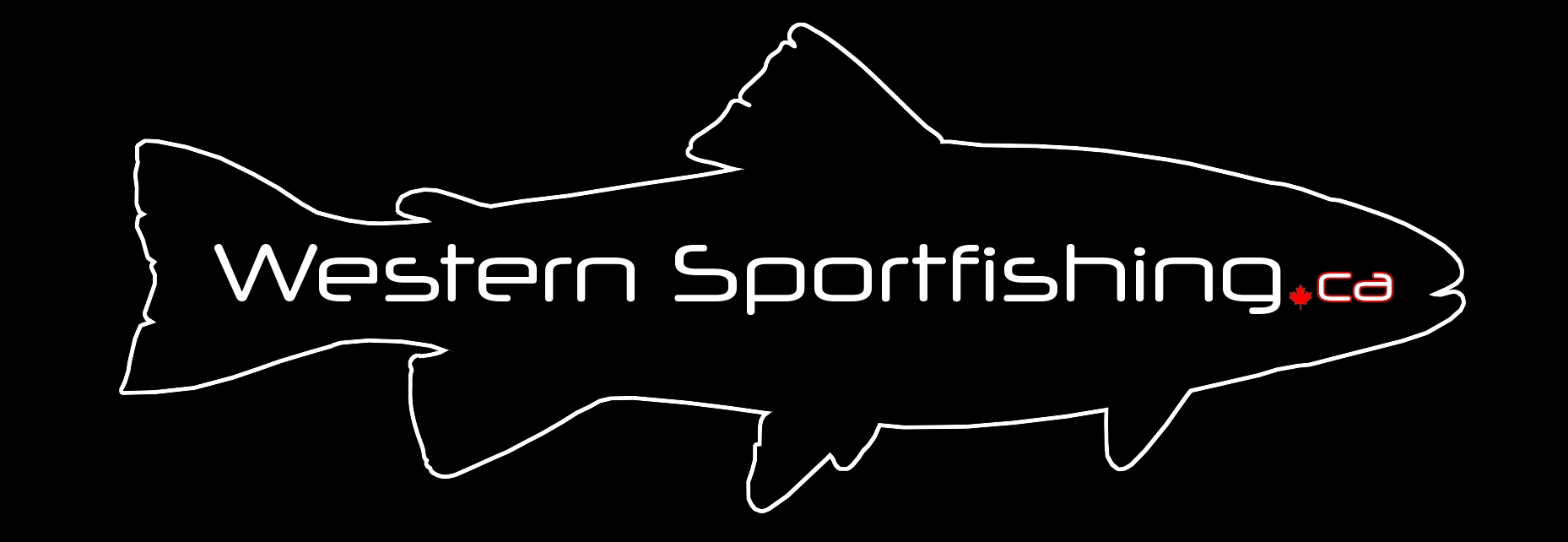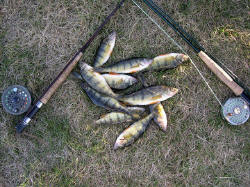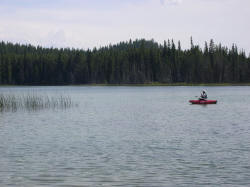
Confessions of a Chironomid Addict
I
had only just launched my float tube, and had stopped on the path to
the good spot to wait for Tim and Andy to launch their boats.
As I was waiting, I tied on a #12 big black bomber, attached an
indicator about 8 feet up the leader, and cast it out, figuring I
might as well have something in the water. It only took about
30 seconds before the indicator made a little twitch, and I lifted
up the rod to find that I had a nice 16” trout attached to the other
end. Andy looked over in disbelief that I already had one on.
It took a couple minutes to land. After I released it, I
tossed my fly back out there. It took less time for me (and
Andy for that matter) to repeat the performance. Needless to
say, they hurried to get into the water, and we soon made our way to
the choice shoal…
Such is chironomid fishing. You are often surprised, often
frustrated, and often you don’t even know what to think, as happened
that day. By the end of the day, Tim and I had lost count of
how many fish we caught. Andy was having a hell of a time
trying to keep a fish on, but once he figured the timing out on the
hook set, he had a fine day.
The
choice shoal we were fishing on had all the characteristics I look
for when chironomid fishing. It was anywhere from 8-17 feet
deep, but the majority was 10-14 feet, and it had a gentle slope.
There were weeds in the bottom 2-4 feet of the water column, and the
bottom was a tad muddy, making for supreme hatches of larger than
average chironomids. NOTE: Fish finders are great here.
They tell you the depth, weed depth, and bottom composite. We
were actually between an island and the lake shore, which is often a
superior place to fish, as fish are forced to cruise through this
area. We also have good success fishing chironomids on the
edge of a drop off, as fish will cruise just off this, and pick
insects off which are free floating or swimming off the lake bottom.
Our
set up was nothing new; it was the way we always chironomid fish:
floating line on a 9 foot, 5 or 6 weight rod; A 12 foot leader (we
use up to 16 or so feet), and an indicator to keep the fly
suspended, and to aid us in detecting a strike. We were all
fishing out of our float tubes, but using a pontoon boat or aluminum
boat is often a better choice as one has a higher vantage point.
This makes detecting strikes a lot easier. Mobility is also better,
in case several locations have to be tried to find fish. The
best times to chironomid fish are May and June, and again in
September and October, but the fishing can be good any time of year.
The
way to fish chironomids is really quite simple, very relaxing, and
once you have it down, is damn successful. Find a shoal that
has the characteristics that were described above. Once you
have found a suitable area, you should anchor there. If you
are using an aluminum boat, you should double anchor (one fore, one
aft) to prevent the boat from turning, and to prevent you from
losing touch with your fly. Depending on the amount of wind,
you can cast in any direction. With a float tube or pontoon
boat, it is easiest to cast downwind, as you kick backwards to keep
your position against the wind. If you are using a boat, you
can cast upwind if it is not too strong, and keep a tight line as
the breeze slowly drifts your fly towards you. Or you can
simply cast downwind. One little trick we like to use to cover
just a little more water is to cast down, and slightly across the
waves. Your fly will swing slowly on a tight line, and cover
just a little more water than you cover by casting straight
downwind.
A
significant thing to have and use, is a throat pump. The hatch
will more than likely change throughout the day, and the use of a
throat pump can clue you in on what fly you should be using.
Get the throat pump wet, suck some water in and squirt it out a
couple times. Insert the depressed pump into the fish’s mouth
carefully, until you can feel it in the esophagus. Slowly
remove the pump, and the vacuum you have created with it sucks the
last few food items the trout has eaten into the pump. Release
the fish, and examine the contents. The really neat thing is
that many of the food samples will contain live specimens, showing
you just how recently the fish has eaten them.
For
flies, all of us really like thread bodies, frostbite bodies and
candy cane chrironomids (see fly tying section). I prefer to
use
 either silver or black beads on my chironomids, as
copper just looks unnatural. Common sizes to use are #10-18.
Be sure to carry a large variety of colours and sizes, but always be
sure to at least have black, olive, brown and maroon, as these are
usually the most effective colours. If you are unsure of what
to use to start your day, I suggest a #12-14 black chironomid, or a
candy cane in the same size.
either silver or black beads on my chironomids, as
copper just looks unnatural. Common sizes to use are #10-18.
Be sure to carry a large variety of colours and sizes, but always be
sure to at least have black, olive, brown and maroon, as these are
usually the most effective colours. If you are unsure of what
to use to start your day, I suggest a #12-14 black chironomid, or a
candy cane in the same size.
As I was floating around in the lake, I couldn’t help but think back to the time when I introduced Tim to the lake. Floating around the same shoal, similar results, and rainbows which had fattened up quite nicely during the summer months (were were actually nailing fish on chironies in mid August!). Come to think of it, I can’t recall a more perfect day fishing out on the lake. The sun was shining, the temperature was right, and when you can fish chironomids successfully all day, you see a whole lot of gorgeous trout as well.
Written by: Nick Sliwkanich

